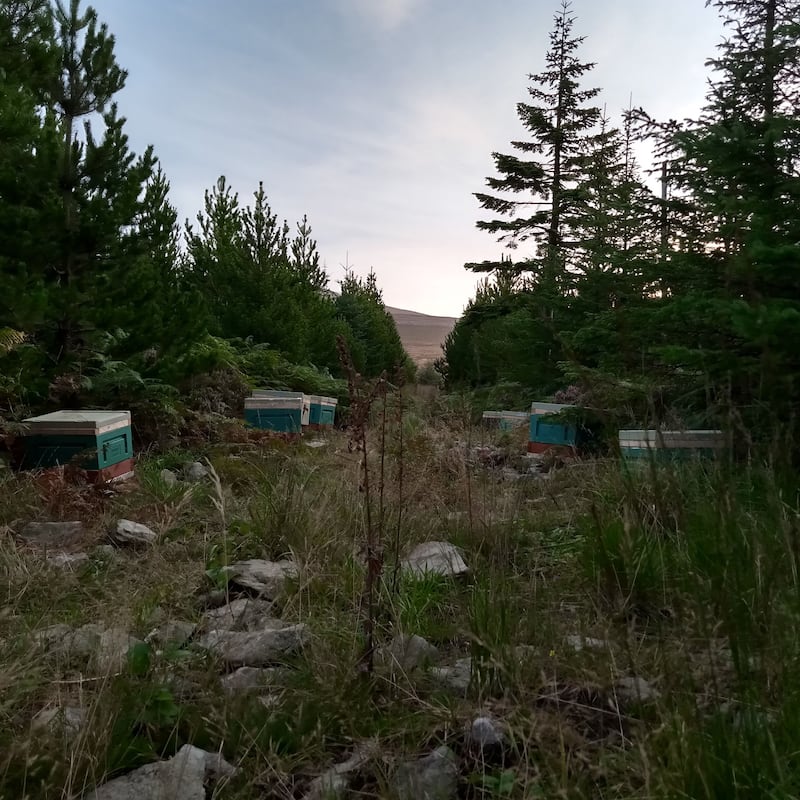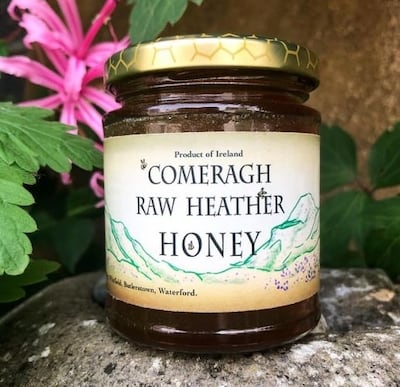Most artisanal food products are the result of the labours of a few dedicated employees. Conor Trihy numbers his workforce in the tens of thousands.
As the 29-year-old makes the rounds of one of his workplaces on a sunny early fall afternoon, they are all abuzz. Trihy is a beekeeper, and he and his workers make some of the best honey you’ll ever taste.
Because of the prevalence of the industrialised product – sometimes little more than sugar water – we have become used to the idea of honey being nothing more than a neutral sweetener.
But real honey is a glorious thing, richly flavoured from whatever flowers the bees that produce it were feeding on. True wildflower honey offers intriguing hints from summer clover and budding trees.
RM Block
There is another step above even that, however. And this is where Trihy’s Comeragh Raw Heather Honey comes in. Really great honeys such as this balance that complex sweetness with a subtly bitter undertone that serves to balance the flavours in the same way that acidity lends structure to wine. Trihy’s wildflower honey, labelled Whitfield Raw Honey, is gorgeous, with a dark, musky floral character. It is only produced in the summer, mainly from clover, blackberry and lime tree flowers.
I got four or five stings on my face today, but you wouldn’t know it
— Conor Trihy on the perils of collecting honey
The heather honey is thick and even more intensely flavoured, and can be collected for only about a month every year and sometimes only for a couple of weeks. It makes up only about 10 per cent of Trihy’s total production.
Naturally, great honey costs more than the industrial product. And there isn’t much of it. The relative scarcity is reflected in the price. Heather honey runs €12.95 for a 230g jar, while the Whitfield wildflower costs €6.50 for 230g. Distribution is very limited – Ardkeen Quality Foods in Waterford, Cove Stores in Tramore, and the Dún Laoghaire and Mahon Point markets.

One September afternoon Trihy is preparing to collect the heather honey from a group of 18 hives on a ridge low on the Comeragh mountains. Below stretches a patchwork of green farm fields clear to the sea. Behind is a shallow stand of conifers that offers some protection from the wind, because behind that is the naked heather-strewn expanse of the mountain face. Trihy manages another four or five heather honey hive locations in the foothills and more wildflower honey hives in the flatlands. Most of the locations are arranged by word-of-mouth or by cold-calling on local farmers.
Trihy is kitted up in a well-used beekeepers’ suit that covers him from head to toe, but that doesn’t stop the bees from paying attention. Sometimes their buzzing gets so loud that it is difficult to hear what he is saying.
[ I thought beekeeping would be easy. The bees had other plansOpens in new window ]

It is hard to exaggerate just how many bees there are. When Trihy pulls the top off of a hive, all you see is a heaving mass. For the most part they are pretty well-behaved. He jets in a few puffs of smoke before starting and that seems to have a calming effect. Still, while he works the hives, the swarm surrounds him, mostly out of curiosity it seems rather than anger.
Not that his job is without peril. “I get stung most days in summer,” he says. “It just becomes a non-event after a few years. I got four or five stings on my face today, but you wouldn’t know it.
“Most of the stings are my own fault. Maybe I’m getting nosy and come in to have a look at a hive without fully suiting up. And when they’re on the heather for some reason they’re not always in the best of humour.”
Though there has been much concern about the decline of wild bee populations, Trihy uses domesticated European bees (Apis mellifera) for his honey and says he hasn’t seen more than the normal swings in numbers. Bees are short-lived in the best of conditions and he says the 10 per cent of hives he normally loses in the course of the working year are easily made up in the spring.
In Ireland we have just a limited chance to make honey. So my job is having the bees ready for when that chance comes
Trihy began keeping bees as a teenager, helping out his grandfather Paddy Trihy, who lives near Portlaw. After studying agriculture at what was then Waterford Institute of Technology, he started keeping bees full-time seven years ago.

These hives are two-storey affairs made from rough wooden boxes. The top floor is where the bees store the honey, the bottom is the domain of the queen, who keeps producing more bees. For ease of production, the two levels are separated by a board called a queen excluder. Before collecting the honey, Trihy removes the excluders, which allows the bees working the top story to congregate around the queen.
The bees deposit the honey on thin vertically hung frames. To collect it, Trihy removes the wax caps, then agitates the honeycomb capsules with needles to liquefy the honey. Finally, he runs the honey through a centrifuge to separate the last of the wax.
The heather honey usually yields only about 10-15lb per hive. The summer honey is more productive, usually double that.
The actual production of the honey is only a small part of Trihy’s work. Most of his effort goes into keeping his workers healthy and ready to produce.
This is particularly important in Ireland where good summer weather seems to come only in short unpredictable spurts. “In Ireland we have just a limited chance to make honey,” says Trihy. “So my job is having the bees ready for when that chance comes.
“The whole year revolves around keeping them strong and vigorous in hopes that they get some break in the weather and can make the most of it and put away enough honey to last.
“That’s what all the management revolves around. Lots of little things.”


















